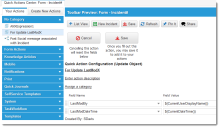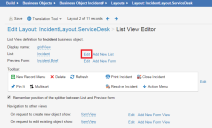Service Manager
Example: Highlighting Certain Incidents in a List
This example explains how to highlight incidents in a list where the incident or a child business object has been modified by someone who is not the owner. This lets the owner quickly see where there is something they need to review.
This procedure involves several steps:
•Creating a Quick Action for the Incident Business Object
•Creating the Triggered Action Business Rule on the Child Business Objects
•Creating the List Formatting Rule
Creating a Quick Action for the Incident Business Object
This example creates a quick action on the incident business object to update the appropriate fields (such as LastModBy and optionally LastModDateTime). See Creating a Quick Action.
1.Log into the Service Manager Application.
2.Open the Incident workspace.
3.From the Action Menu, choose Edit Actions. The application displays the Quick Action Editor.
4. Under Create New Actions, click Update Object.
5.Enter information into the fields.
| Field | Description |
|---|---|
| Enter action name | Force Update LastModX |
| Enter action description | Quick action for highlighting incidents. |
| Enter category | Assign a category as needed. |
| Field Name | From the drop-down list, select LastModBy. |
| Field Value | Enter $(CurrentUserDisplayName()). |
| Field Name | From the drop-down list, select LastModDateTime. |
| Field Value | Enter $(CurrentDateTime()). |
To add additional field names and values, click the add  icon.
icon.
6.Click Save.
Update LastModX Quick Action
7.Close the Quick Action Editor and test the quick action.
Creating the Triggered Action Business Rule on the Child Business Objects
This procedure describes how to create business rules on each of the child business objects to run the quick action on an incident when a record is created or updated.
1.From the Configuration Console, click Build > Business Objects to open the Business Objects workspace.
2.Open the business object called Task.Assignment.
3.Click the Business Rules tab.
4.Expand the Triggered Actions header and click Add Trigger.
5.Enter a unique name for the triggered action business rule, such as IncidentTAForceUpdateLastModX.
6.Choose events (for example, On Initialize, On Insert, On Update), add any applicable values, and click Next.
7.Select Configure new action and select Run for Child from the drop-down list.
8.Click Next.
9.In the Child object and relationship field, select IncidentAssocTaskAssignment.
10.In the Action to run field, select the quick action that you created previously, such as Force Update LastModX.
11.Click Save.
12.Test the business rule in all use cases.
13.Repeat these steps for each child business object to affect the row highlighting.
Creating a Formatting Style
1.From the Configuration Console, click Build > User Interface Styles > Highlighter Styles to open the Highlighter Styles workspace.
2.Click Add new.... The application displays the New Style workspace.
3.Enter a name and description for the style.
4.Drag and drop any styles to format. For example, drag the border-color property onto the Dynamic Style Definition area, then from the Value drop-down list, select light yellow (#FFFF99).
Example Highlighter Styles
5.Click Save.
Creating the List Formatting Rule
1.From the Configuration Console, click Build > Business Objects to open the Business Objects workspace.
2.Open the Incident business object.
3.Click the Layouts tab. The application displays a list of layouts.
4.Select the layout to apply the format to, ensuring that it is related to the appropriate role. For example, select IncidentLayout.ServiceDesk.
5.Click gridView to open the form in the List View Editor.
6.Click Edit (next to Add New List) to modify the list.
List View Editor
7.The application only applies styles to the columns that are defined in the list, so add any additional fields as columns to the list, if they are missing.
For this example, we want to highlight the LastModBy and LastModDateTime fields, so ensure that both of these fields are displayed as column headers on the list.
Adding the LastModBy Field to the List Layout
8.While the column is highlighted, on the right, from the Style field, select the new style that you created in Creating a Formatting Style.
9.Click Save.
10.Test the rule in your Incident workspace.
Whenever anyone modifies an incident or an affected child business object of the incident, the application updates the LastModBy field of the incident. If the value of the LastModBy field is not the same as the value of the Owner field, the application highlights it.
List Highlight Results
Was this article useful?
Copyright © 2020, Ivanti. All rights reserved.




